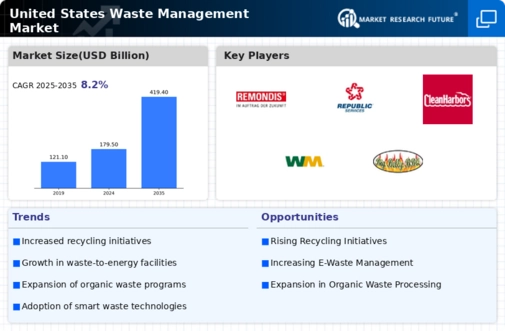US Waste Management Market Summary
As per Market Research Future Analysis, the United States Waste Management Market was valued at 179.52 USD Billion in 2024 and is projected to grow to 418.66 USD Billion by 2035, with a CAGR of 8.00% from 2025 to 2035. Key drivers include increased construction and demolition activities and rising demand for waste management services. The Industrial Waste segment leads the market, driven by urbanization and industrial growth. Landfills generate the highest revenue among waste management services, ensuring compliance with environmental regulations.
Key Market Trends & Highlights
The United States Waste Management Market is influenced by several key trends.
- Market Size in 2024: 179.52 USD Billion.
- Projected Market Size by 2035: 418.66 USD Billion.
- CAGR from 2025 to 2035: 8.00%.
- Industrial Waste segment dominates due to urbanization.
Market Size & Forecast
| 2024 Market Size | USD 179.52 Billion |
| 2035 Market Size | USD 418.66 Billion |
Major Players
Key players include REMONDIS SE & CO. KG, HITACHI ZOSEN CORPORATION, REPUBLIC SERVICES, INC., BIFFA PLC, CLEAN HARBORS, INC., WASTE MANAGEMENT INC., BIGBELLY, INC., VEOLIA ENVIRONNEMENT S.A., COVANTA HOLDING CORPORATION, SUEZ ENVIRONMENTAL SERVICES.
















Leave a Comment